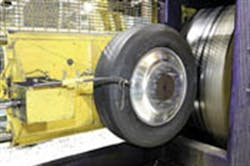NHTSA remains mum on truck tire test results, rule revisions: Changes must reflect real-world conditions, say tiremakers
In this, the first in a two-part update on government standards for the commercial truck tire market, we examine where things stand regarding revisions to the existing truck tire rule.
When it comes to revisions to the federal standard that governs medium truck tires, the unknowns currently out-number the knowns.
What's known is the National Highway Traffic Safety Administration (NHTSA) is developing a revised version of Federal Motor Vehicle Safety Standard (FMVSS) 119, and is conducting road wheel speed and endurance tests as part of its efforts to establish more up-to-date regulations. (FMVSS 119 dates back to the mid-1970s.)
It's also known that NHTSA hopes to publish a notice of proposed rulemaking regarding FMVSS 119 by the end of the year.
However, NHTSA is keeping what it's learned very close to its vest.
"We're anxiously awaiting any information with any substance to it," says Paul Fiore, director of government and business relations for the Tire Industry Association.
"They're not going to share any of the data until the notice of proposed rulemaking comes out," says Dan Zielinski, vice president of communications for the Rubber Manufacturers Association.
[PAGEBREAK]
Tire manufacturers find themselves in the same boat.
"They won't give anyone a sneak preview," says Guy Walenga, engineering manager, commercial products, for Bridgestone Firestone North American Tire LLC.
Test concerns
NHTSA says it is testing truck tires using a 67-inch steel drum. The tests "are able to simulate the loads, speeds and duration of long haul trucks on today's interstate highways," says NHTSA spokesperson Elly Martin.
When the original rule was written some 30 years ago, bias-ply 10.00x20 was probably the main truck tire, according to Walenga.
"They want (a standard) that would reflect more real-world applications; in other words, heavier loads, higher tire speeds and longer durations. And we have no problem with that. I don't think the industry argues with that one bit."
Michelin North America Inc. "fully supports a standard that is appropriate to real world conditions," says Mike Wischhusen, director, industry standards and government regulations, for Michelin.
"Real world" is the key term, says Greg Camarato, director, government compliance and product performance, Goodyear Tire & Rubber Co.
That's something that a road wheel test may not be able to achieve, according to tiremakers, because running a tire against a test drum generates more heat than running a tire on the highway.
It's a matter of physics, says Wischhusen. "If you think about a tire, a round object, being pressed against a steel drum, another round object, the tire will deform more than it would deform on a flat road surface.
[PAGEBREAK]
"Running a tire 75 mph on a wheel is much more punishing than 75 mph on a flat highway. The temperature goes up and you start seeing thermal-type failures that you don't see on the highway.
"I don't want to fail tires on a wheel test (due to) conditions you don't see in the real world."
NHTSA would be able to change any testing variable -- load, pressure or speed -- to establish a more realistic test and achieve more accurate results."
Fortunately, he notes, NHTSA isn't going it alone. The agency is working with ASTM International, formerly known as the American Society for Testing and Materials, to develop test procedures for FMVSS 119. (ASTM helps develop technical standards for various industries. A Michelin employee, Steve Padula, chairs ASTM's tire committee.)
"The government isn't trying to put anyone out of business," says Walenga. "They're not trying to make a test that nobody can pass."
The October edition of CTD will look at possible NHTSA retread regulations.
